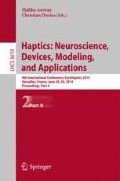Abstract
Weber’s law describes the linear drop of discriminative performance with increased base intensity of a stimulus. So far, this phenomenon has been modeled using multistable attractor decision networks based on the principle of biased competition between two mutually inhibiting recurrent neural populations. Due to the sensitive balance in a multistable fluctuation-driven regime, these decision models can only account for Weber’s law in a narrow stimulus range. Psychophysical data shows though that the human exhibits this characteristic for a broad stimulus range. Recent neurophysiological evidence suggests that global feedforward inhibition expands the dynamic range of cortical neuron populations and acts as a gain control. In this paper, we introduce a computational model that exploits this type of inhibition and shows through a fit between simulation results and psychophysical data that it is a potential explanation for the principle mechanism behind Weber’s law.
Access this chapter
Tax calculation will be finalised at checkout
Purchases are for personal use only
References
Craig, J.C.: Difference threshold for intensity of tactile stimuli. Percept. Psychophys. 11, 150–152 (1972). Springer
Deco, G., Scarano, L., Soto-Faraco, S.: Weber’s law in decision making: integrating behavioral data in humans with a neurophysiological model. J. Neurosci. Soc. Neurosci. 27, 11192–11200 (2007)
Fechner, G.T.: Elemente der Psychosophysik. vol. 2 (1860)
Gabernet, L., Jadhav, S.P., Feldman, D.E., Carandini, M., Scanziani, M.: Somatosensory integration controlled by dynamic thalamocortical feed-forward inhibition. Neuron 48, 315–327 (2005). Elsevier
Gentet, L.J., Avermann, M., Matyas, F., Staiger, J.F., Petersen, C.C.: Membrane potential dynamics of GABAergic neurons in the barrel cortex of behaving mice. Neuron 65, 422–435 (2010)
Gescheider, G.A.: Psychophysics: the fundamentals. Psychol. Press. 65, 422–435 (1976)
Harvey, M.A., Saal, H.P., Dammann III, J.F., Bensmaia, S.J.: Multiplexing stimulus information through rate and temporal codes in primate somatosensory cortex. PLoS Biol. Pub. Lib. Sci. 11, e1001558 (2013)
Kawaguchi, Y., Kubota, Y.: GABAergic cell subtypes and their synaptic connections in rat frontal cortex. Cerebral Cortex 7, 476–486 (1997). Oxford Univ Press
Machens, C.K., Romo, R., Brody, C.D.: Flexible control of mutual inhibition: a neural model of two-interval discrimination. Science 307, 1121–1124 (2005). American Association for the Advancement of Science
Moore, A.K., Wehr, M.: Parvalbumin-expressing inhibitory interneurons in auditory cortex are well-tuned for frequency. J. Neurosci. Soc. Neurosci. 33, 13713–13723 (2013)
Okun, M., Lampl, I.: Instantaneous correlation of excitation and inhibition during ongoing and sensory-evoked activities. Nat. Neurosci. 11, 535–537 (2008)
Pouille, F., Marin-Burgin, A., Adesnik, H., Atallah, B.V., Scanziani, M.: Input normalization by global feedforward inhibition expands cortical dynamic range. Nat. Neurosci. 12, 1577–1585 (2009). Nature publishing group
Rothenberg, M., Verrillo, R.T., Zahorian, S.A., Brachman, M.L., Bolanowski Jr., S.J.: Vibrotactile frequency for encoding a speech parameter. Acoust. Soc. Am. 62, 1003–1012 (1977)
Runyan, C.A., Sur, M.: Response selectivity is correlated to dendritic structure in parvalbumin-expressing inhibitory neurons in visual cortex. J. Neurosci. Soc. Neurosci. 33, 11724–11733 (2013)
Smith, P.L., Ratcliff, R.: Psychology and neurobiology of simple decisions. Trends Neurosci. 27, 161–168 (2004). Elsevier
Usher, M., McClelland, J.L.: The time course of perceptual choice: the leaky, competing accumulator model. Psychol. Revi. 108, 550–592 (2001). American Psychological Association
Wilson, N.R., Runyan, C.A., Wang, F.L., Sur, M.: Division and subtraction by distinct cortical inhibitory networks in vivo. Nature 488, 343–348 (2012)
Wong, K.-F., Wang, X.-J.: A recurrent network mechanism of time integration in perceptual decisions. J. Neurosci. 26, 1314–1328 (2006)
Author information
Authors and Affiliations
Corresponding author
Editor information
Editors and Affiliations
Rights and permissions
Copyright information
© 2014 Springer-Verlag Berlin Heidelberg
About this paper
Cite this paper
Friedl, K.E., Qin, Y., Ostler, D., Peer, A. (2014). Modeling the Weber Fraction of Vibrotactile Amplitudes Using Gain Control Through Global Feedforward Inhibition. In: Auvray, M., Duriez, C. (eds) Haptics: Neuroscience, Devices, Modeling, and Applications. EuroHaptics 2014. Lecture Notes in Computer Science(), vol 8619. Springer, Berlin, Heidelberg. https://doi.org/10.1007/978-3-662-44196-1_48
Download citation
DOI: https://doi.org/10.1007/978-3-662-44196-1_48
Published:
Publisher Name: Springer, Berlin, Heidelberg
Print ISBN: 978-3-662-44195-4
Online ISBN: 978-3-662-44196-1
eBook Packages: Computer ScienceComputer Science (R0)

